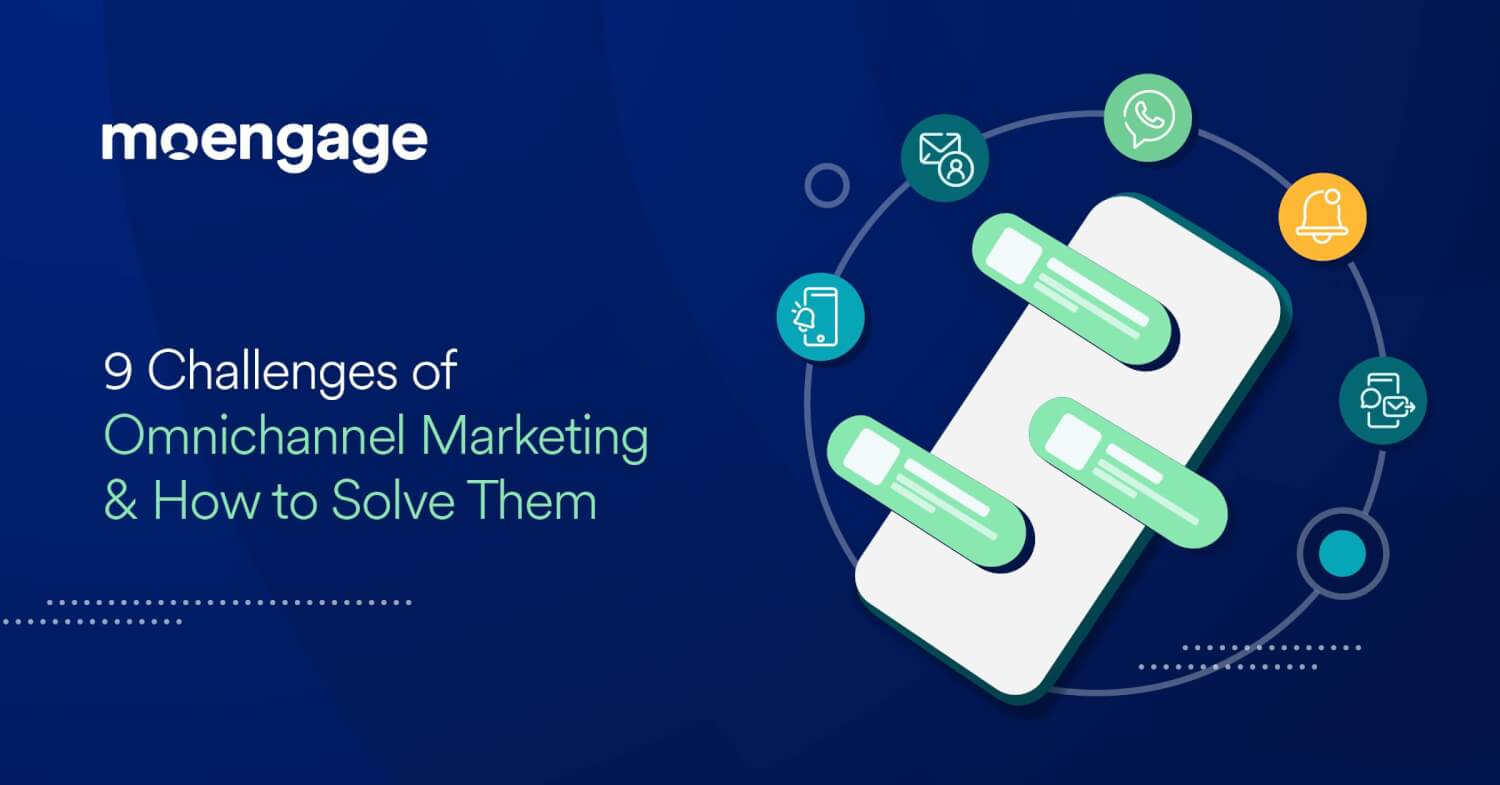9 Challenges of Omnichannel Marketing & How to Solve Them

Reading Time: 7 minutes
Customers have high demands and expectations from the brands they interact with, and if you fail to meet those expectations, they’ll look elsewhere. An omnichannel marketing approach is essential in today’s fast-paced, customer-centric world, allowing brands to give customers a smooth, seamless experience across online and offline touchpoints.
But managing an omnichannel campaign is no simple feat.
Delivering consistent brand experiences when operating on various channels, addressing different customer segments, and managing multiple campaigns simultaneously can be incredibly challenging. B2C marketers must get these factors right each time to maximize engagement and elicit conversions. They need a plan to resolve the biggest challenges of omnichannel marketing before those challenges negatively impact their campaigns.
To help you do that, we explore the top challenges of omnichannel marketing that B2C marketers experience (and how to solve them!).
9 Omnichannel Marketing Challenges and How to Fix Them
Not all industries or companies are impacted by the same challenges, so remember that some of these afflictions may affect you more prominently or insignificantly depending on your niche, your customers, and other factors unique to your brand.
However, most B2C marketers will want to watch out for these 9 omnichannel marketing challenges.
1. Effective communication strategy
According to a survey conducted by OneSpot, 78% of US shoppers confirmed that relevant content increases their purchasing intent for a brand’s products and services. But far too often, the messages they receive simply aren’t related to their needs or preferences.
A spray-and-pray approach where you put out as much content as possible without putting deep thought into each piece of content’s purpose will make it irrelevant to specific segments of customers, and that would mean potentially losing out to your competitors.
How to fix it: The messaging you choose for your marketing is pivotal to the success of an omnichannel marketing strategy. Brands must personalize their messaging across the channels they use to connect with customers. Whether that’s app, web, push, or email, the content, tone, and style of your messaging are crucial to its resonance.
To understand your buyer’s persona, analyze the types of content they engage with most. Do they interact with promotional offers, informational content, or new product or feature launches most often? Then, leverage these insights to tailor your content strategy to send messages that each customer segment will adore.
2. Rely on accurate, current data for your insights
Omnichannel marketers must make many decisions about their campaigns, including what channels to use, which campaigns to employ for which scenarios, when to send messages for the most traction, and which segments to target with different messages. To consistently make the right choices regarding campaign optimization, brands need their data to be current, accurate, and in sync.
Unfortunately, many brands have data that is disjointed and out-of-date. As you can imagine, any issues with data can spell disaster for campaign decision-making. Inaccurate data leads to faulty insights. The outcome? Campaigns that completely miss the mark.
How to fix it: A 360-degree view of your customers and prospects from an insights-driven customer engagement platform is imperative for a successful omnichannel marketing campaign. Ensure that omnichannel analytics influence your strategy to create a comprehensive (and valid) picture of your customers’ activity.
3. Aligning all teams and democratizing data
An omnichannel strategy has many moving pieces. Getting buy-in from all stakeholders and aligning on objectives is no easy task. For brands to be successful, they need data democratized across the organization so that all teams have access to insights and input on strategy.
How to fix it: Make sure all teams are on the same page and working towards the same goals. Clearly define your objectives and set measurable benchmarks to track your performance, providing organization-wide exposure so all teams are in the loop. Ensure that all the information you receive about the customer is available in a unified system so your sales and marketing teams can access it and collaborate to deliver relevant offers to customers.
Build a customer journey map to understand where each team can be leveraged to add value, and define where and how they will contribute. Ensure all teams can access insights, make necessary updates, and communicate with each other to ensure the entire organization is in sync and working towards the same goal.
4. Proactively using real-time data
One of the biggest challenges is sending customers temporally and contextually relevant messages. Customers are unlikely to engage with — or even open — these messages if they don’t hit the mark.
Too often, brands filter customers into generic campaigns that deliver messages at arbitrary times. The result is campaigns that fail to connect with where the customer is in their journey or what they are trying to do. When possible, it’s best to send customer messages in real time, based on an action the customer has just taken.
How to fix it: Immediately following up ensures that your messages are always relevant to what your customers are doing—when they are doing it. This could be mobile notifications that alert a customer that a transaction has just occurred or an SMS message that allows the customer to confirm a reservation, order, or pickup. It can even be marketing campaigns that promote relevant products, services, or offers.
You can also leverage real-time data to be proactive (rather than reactive) about engagement, sending customers in-app messages after a customer shows signs they’re likely going to abandon their cart. This empowers you to deploy campaigns likely to gain traction based on the customers’ likely trajectory.
5. Campaign coordination across channels
When executing an omnichannel campaign, transitioning between channels must be effortless and smooth for customers. This means brands need to provide customer-guided experiences that leverage all touchpoints most effectively.
This becomes even more challenging with the proliferation of new channels, such as social media and mobile apps, which must be factored into every campaign and continuously managed and iterated over time.
According to insights from 312.4 million customer emails, journey-based personalization had one of the greatest impacts on successful personalization efforts across different industries. Most notably, journey-based personalization was the leading factor for open rates and click-to-open rates across all industries. It also ranked either highest or second highest for conversion rates and lowest or second lowest for unsubscribe rates across the board.
How to fix it: Shift your focus from the channels themselves to customer experiences. The best way to achieve this is through the use of a customer engagement platform that can perform customer journey orchestration and offer actionable insights and capabilities that allow you to act quickly on them.
6. Measuring the right KPIs
A consumer passes through five stages of the buyer’s journey – awareness, consideration, decision, retention, and advocacy. For an omnichannel customer journey to be successful, marketers must ensure that they are looking at the right signals to measure performance at every stage in the customer’s journey.
While most marketers measure the campaign’s overall effectiveness, they fail to dig deeper into the performance of campaigns across the buyer’s entire journey which is why this is one of the most critical challenges of omnichannel marketing. Without doing this, it’s impossible to identify which parts of your customer journeys are drawing in customers and which are causing customers to churn. It also means you’ll struggle to hone in on which channels, devices, and messages are most effective.
How to fix it: Success isn’t about measuring as many metrics as you can, it’s about measuring the right metrics and understanding how to use them to understand customer behavior and improve your customer experience and campaigns. That means identifying which KPIs provide valuable, actionable insights and allow you to get more value each time you iterate a campaign.
This empowers you to dive into your analytics to understand where your customers are coming from, what motivates them to sign up, and how they use your products and services.
Insights like this collected from an engagement analytics platform like MoEngage will help you create relevant messages for your prospects and enable omnichannel personalization, which keeps individual customers more engaged throughout their journey—and, therefore—more likely to convert at the end of it.
7. Ability to reduce churn
Within competitive sectors like ecommerce, marketers may find it difficult to reduce churn and retain customers, especially when the competitors offer the same products at lower prices. Therefore, creating differentiation becomes a challenge.
With more touchpoints comes more points for customers to drop off, and you need to nail every single interaction to keep customers on track. It’s not surprising that the more channels brands operate as part of their omnichannel campaign and the more intricate their strategy and campaigns get, the harder it is to predict and mitigate churn across them all.
How to fix it: One of the best ways to mitigate churn is to act on customer risk signals in real time, based on customer activity. Run email, on-site, and mobile campaigns that automatically trigger based on what your customers are actively doing to ensure campaigns remain relevant and arrive at the right time. This allows brands to step in and reduce churn with targeted campaigns that anticipate drop-offs before they occur.
8. Meeting customer expectations
Thanks to customer-centric brands like Amazon and Netflix, people now expect hyper-personalized experiences and recommendations. The one-size-fits-all approach has disappeared. Customers won’t think twice before switching to a competitor if they provide a better product, service, or customer experience.
This means brands need to have accurate, reliable data about which channels customers use and which campaigns have the most impact. And the fact is, this is easier said than done. Most brands rely on disjointed, siloed data and have severe limitations on how fast they can optimize their campaigns to improve engagement, making it difficult to meet customer demands.
How to fix it: Don’t just build your omnichannel strategy around what’s easy for you to execute; build it around what your customers will want. According to our Personalization Pulse Check Report, 56% of North Americans expect a curated shopping experience from the brands they shop from regularly. To meet these needs, B2C marketers need to be firing on all cylinders across every available touch point, effortlessly weaving customers between channels.
Overcome Your Omnichannel Marketing Challenges with MoEngage
Let’s face it. Executing an omnichannel strategy is difficult. You need to consolidate your data, manage campaigns across multiple channels, and orchestrate campaigns that let customers transition seamlessly between online and offline channels. Too often, brands struggle to get buy-in from stakeholders, align on their objectives, and work cohesively to perfect their omnichannel campaigns and messages.
However, MoEngage’s Customer Engagement Platform (CEP) helps hundreds of B2C brands create, manage, and optimize their omnichannel campaigns to improve engagement and retention. We’ve designed our platform to address these challenges head-on so you can create dynamic, resonant campaigns that keep customers interested and keep your brand at the forefront of your mind.
Schedule a demo today to find out how MoEngage can help you quickly tackle these challenges so you can focus on creating omnichannel campaigns that your customers love.
















